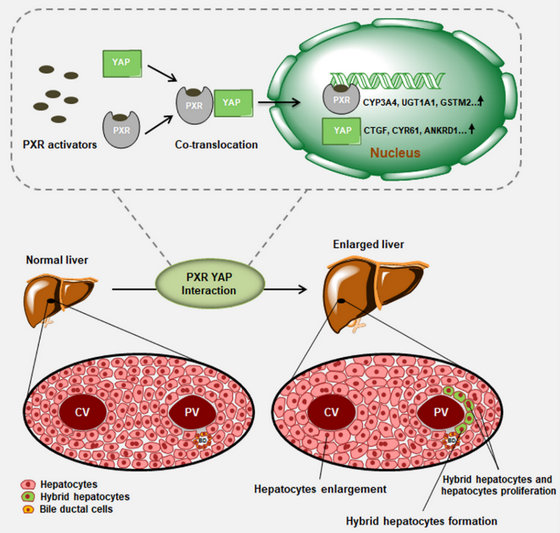Source: School of Pharmaceutical Sciences
Written by: School of Pharmaceutical Sciences
Edited by: Wang Dongmei
Most recently, Prof. Min Huang and Huichang Bi's group at the School of Pharmaceutical Sciences, Sun Yat-sen University published a paper entitled "Pregnane X receptor regulates liver size and liver cell fate via yes-associated protein activation" on Hepatology (2018 Jul 26. doi: 10.1002/hep.30131. PMID:30048004). This study reveals a novel function of PXR in enlarging liver size and changing liver cell fate via activation of the YAP signaling pathway.
Given the many vital functions of the mammalian liver, especially metabolism and xenobiotic detoxification, the ability of the liver to maintain a constant size and mass is critical for organismal survival. PXR has been known as a nuclear receptor and transcriptional regulator that critically regulates xenobiotic metabolism and endobiotic homeostasis. Recently, PXR activation was found to induce significant liver enlargement. However, it is still unknown which cell types within the liver are responsible for the alterations in liver size, and the involved molecular signals remain poorly characterized. In the current study, the effect of PXR activation on liver enlargement and cell change was evaluated in several strains of genetically-modified mice and animal models. Lineage labelling using AAV-Tbg-Cre-treated Rosa26EYFP mice or Sox9-CreERT, Rosa26EYFP mice was performed. Pxr-null mice or AAV Yap shRNA-treated mice were used to confirm the role of PXR or YAP. It was demonstrated that treatment with selective PXR activators induces liver enlargement and regeneration in wild-type and PXR-humanized mice but not in Pxr-null mice by increase of cell size, induction of a regenerative hybrid hepatocyte (HybHP) reprogramming, and promotion of hepatocyte and HybHP proliferation. Mechanistically, after activation PXR interacted with yes-associated protein (YAP) and induced nuclear translocation of YAP. Blockade of YAP abolished PXR-induced liver enlargement in mice. These findings reveal a novel function of PXR in enlarging liver size and changing liver cell fate via activation of the YAP signaling pathway. These results have implications for understanding the physiological functions of PXR and suggest the potential for manipulation of liver size and cell fate.
An editorial entitled “Is this the time to reconsider the names for xenobiotic nuclear receptors?” was also published in Hepatology (2018 Aug 16. doi: 10.1002/hep.30218. PMID: 30113075). The editorial pointed out that the study elegantly provides us a novel mechanism by which PXR activation induced liver hypertrophy and hepatocyte proliferation. This study, together with the recent publications prompt us to reconsider the major functions of PXR and CAR as solely xenobiotic nuclear receptors. The findings from this study may provide profound influence in future studies of liver physiology, pathology and pharmacology.

Proposed mechanisms for PXR regulating liver size and liver cell fate via YAP activation
This work was supported by the National Natural Science Foundation of China and the National Key Research and Development Program of China Ministry of Science and Technology.
Link to the article: https://aasldpubs.onlinelibrary.wiley.com/doi/pdf/10.1002/hep.30131
Link to the editorial: https://aasldpubs.onlinelibrary.wiley.com/doi/abs/10.1002/hep.30218



